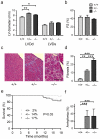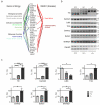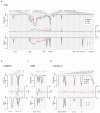RBM20, a gene for hereditary cardiomyopathy, regulates titin splicing
- PMID: 22466703
- PMCID: PMC3569865
- DOI: 10.1038/nm.2693
RBM20, a gene for hereditary cardiomyopathy, regulates titin splicing
Abstract
Alternative splicing has a major role in cardiac adaptive responses, as exemplified by the isoform switch of the sarcomeric protein titin, which adjusts ventricular filling. By positional cloning using a previously characterized rat strain with altered titin mRNA splicing, we identified a loss-of-function mutation in the gene encoding RNA binding motif protein 20 (Rbm20) as the underlying cause of pathological titin isoform expression. The phenotype of Rbm20-deficient rats resembled the pathology seen in individuals with dilated cardiomyopathy caused by RBM20 mutations. Deep sequencing of the human and rat cardiac transcriptome revealed an RBM20-dependent regulation of alternative splicing. In addition to titin (TTN), we identified a set of 30 genes with conserved splicing regulation between humans and rats. This network is enriched for genes that have previously been linked to cardiomyopathy, ion homeostasis and sarcomere biology. Our studies emphasize the key role of post-transcriptional regulation in cardiac function and provide mechanistic insights into the pathogenesis of human heart failure.
Figures






Comment in
-
King of hearts: a splicing factor rules cardiac proteins.Nat Med. 2012 May 4;18(5):660-1. doi: 10.1038/nm.2762. Nat Med. 2012. PMID: 22561820
References
-
- Lin S, Fu X-D. SR proteins and related factors in alternative splicing. Adv. Exp. Med. Biol. 2007;623:107–122. - PubMed
-
- Lukong KE, Chang K.-wei, Khandjian EW, Richard S. RNA-binding proteins in human genetic disease. Trends Genet. 2008;24:416–425. - PubMed
-
- Wang GS, Cooper TA. Splicing in disease: disruption of the splicing code and the decoding machinery. Nat Rev Genet. 2007;8:749–761. - PubMed
Publication types
MeSH terms
Substances
Associated data
- Actions
- Actions
Grants and funding
LinkOut - more resources
Full Text Sources
Other Literature Sources
Molecular Biology Databases

